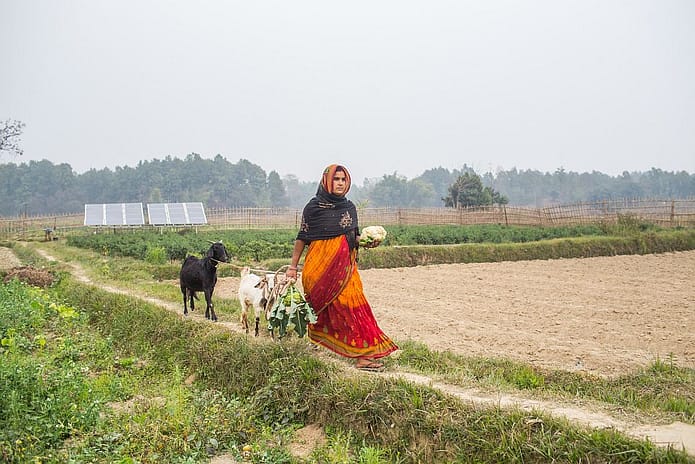Gender equality and women’s and girls’ empowerment has featured prominently in development discourse for the last two decades and today comprises one of the sustainable development goals (SDGs).
But how can we support women’s empowerment?
The SDG5 features several targets that revolve around two types of action: (1) increasing women’s agency, through enhanced participation in political and social organizations and (2) enhancing access to economic resources, including land and facilitating the use of technologies. Recent fieldwork on women’s empowerment in western Nepal suggests that targeting women might not be sufficient to achieve gender equality. At least in the South Asian context, to be effective and sustainable, gender transformative actions also need to involve men and consider the social relationships within which women exercise their agency.
Women’s leadership within male-defined boundaries
In Sanogao[1] a village of Kailali District, western Nepal, most women described Manita as the most empowered woman of their community. For them, Manita is empowered because ‘she left her household work to get stuff done. She is representing women. If we cannot attend a meeting, she will go.’ Manita is the chairperson of a local group from Nirdhan Uttan bank, a regulated micro-finance institution, and of the local Aama Samuha, the mother’s group. She is also member of several other saving groups and the vice chairperson of the school committee.
When asked how she gained the confidence to assume these roles, Manita states: ‘When we held meetings, all husbands said: my wife cannot make it. I received a lot of help from my husband. My husband proposed me and first I said ‘no’ but then he said “you will be fine”’. Other women who hold a position in the executive committees of these groups also mentioned they got involved because their husband proposed them and allowed them to take part. Most of these women are relatively elder and do not have to look after small children. Their husband has a non-farm income, which means they have to rely less on agricultural work – Manita gave her goats to her sister in-law because she did not have time to take care of them. It was therefore easier for them to negotiate with their husband to spend time outside their home.

Manita is seen by other women as empowered. She is outspoken and is a leader. However her leadership and agency is limited to the boundaries of what men see as not threatening their own power. Whereas Manita and other women participate in Savings Groups, men still control the Community Forest User Group, which decides on use of the income generated by wood sales. As the community leader remarked: ‘Men still do most of the work in public, except if they need to borrow money. Then they will send their wife because people trust women more’. Women go to see Manita to get information about saving groups or trainings. However if they want to ‘get things done’, for instance negotiate the type of benefits they would get from a development intervention, they would not ask Manita, but the male community leader.
Increasing women’s income / decreasing men’s expenditures?
Further to the interventions conducted under the USAID funded project ‘Market Access and Water Technology for Women’s Empowerment’, many women started growing vegetables in their homestead garden and selling them on the market. The income is spent on household items such as soap, tea, sugar, etc. However during focus group discussions, women stressed intra-household tensions about the use of income: ‘if we need to buy salt but our husband wants to drink alcohol, he will buy alcohol. He will ask me to borrow salt from the shop’. Or ‘My husband spends on alcohol and tobacco. If I ask my husband for money to buy oil and salt, he always ‘wins’ and buys alcohol‘. During her interview, Rita, an elder woman also recounted how her husband had to sell their house and land because of his addiction to alcohol. Commercial horticulture might relieve women’s stress to have to negotiate with their husband petty cash to buy basic households needs or pay for the children’s school fees but this will not prevent their husband to waste most of the household income on alcohol.
Targeting men to achieve the SDG5?
To achieve gender equality and women’s and girls’ empowerment, it is necessary to increase women’s agency, access to resources and also the critical consciousness that will turn these into achievements that contribute to their own well being and the well being of others.
However, the extent to which such actions are transformative might be limited by the space that their husbands (or mother in-law) leave for them to exercise this agency. Women do not exercise agency and control over resources in a vacuum, but within a set of social relationships that are themselves shaped by broader political-economic structures, institutions, norms and values. For empowerment interventions to be transformative, one has to support change in the social relationships that are oppressive and unjust. Men also need to be ‘empowered’, not in the sense of getting more ‘power over’ but more positive ‘power within’ to become better individuals, husbands and fathers.
This research was conducted under the USAID funded project ‘Market Access and Water Technology for Women’s Empowerment’, led by International Development Enterprises (iDE) in partnership with IWMI, SAPPROS Nepal, Samjhauta and NTAG.
[1] For confidentiality reasons, we changed the names of the village and persons mentioned in this blog
















